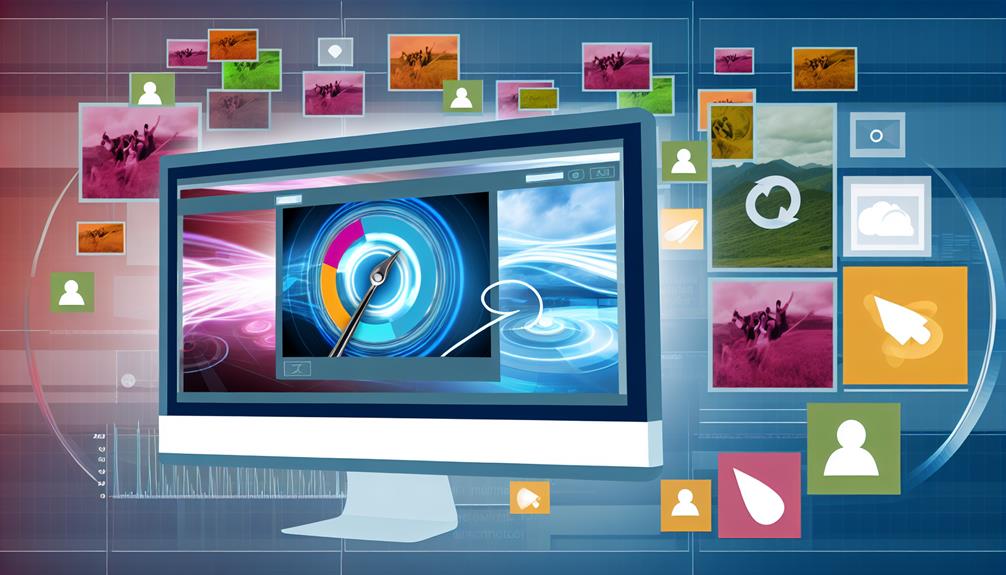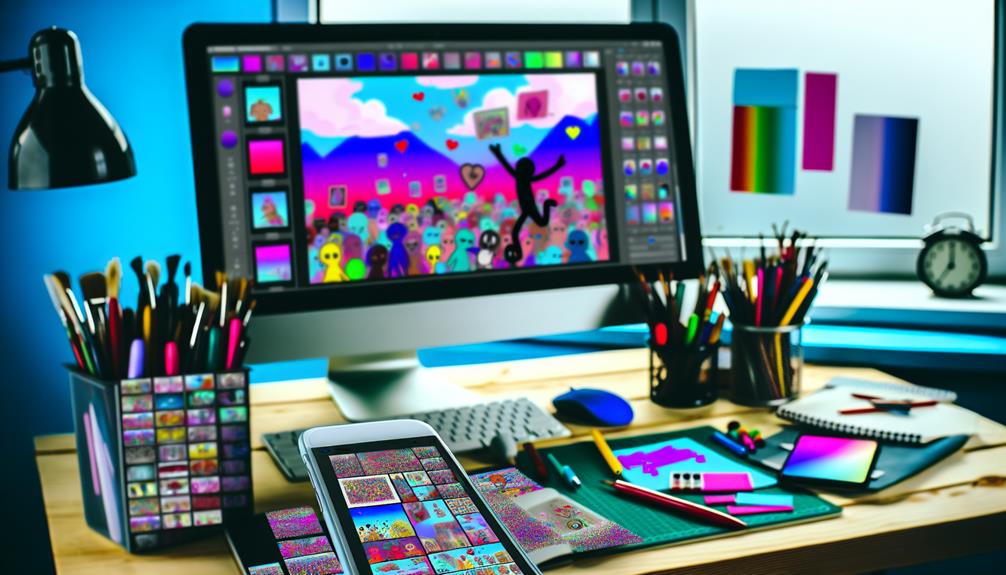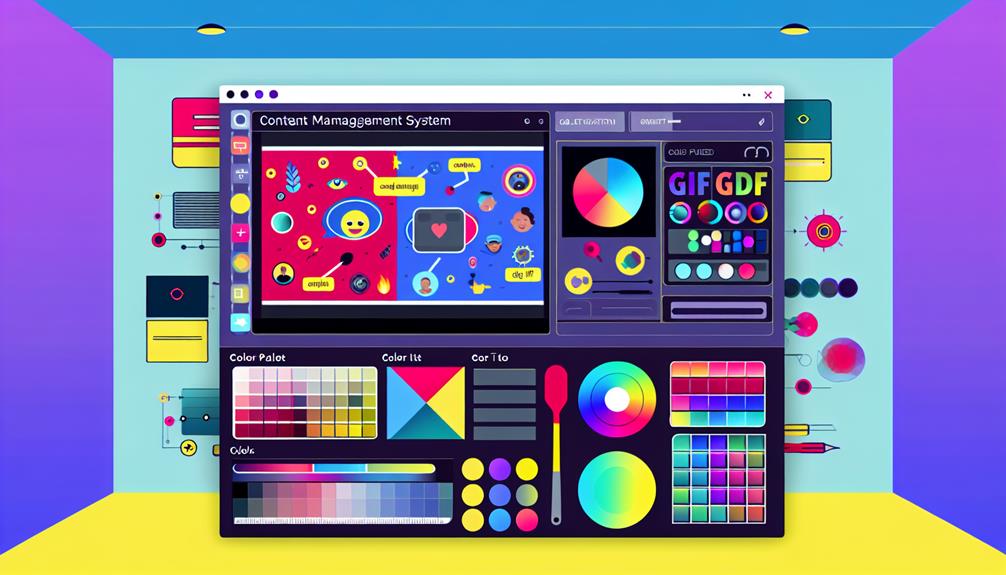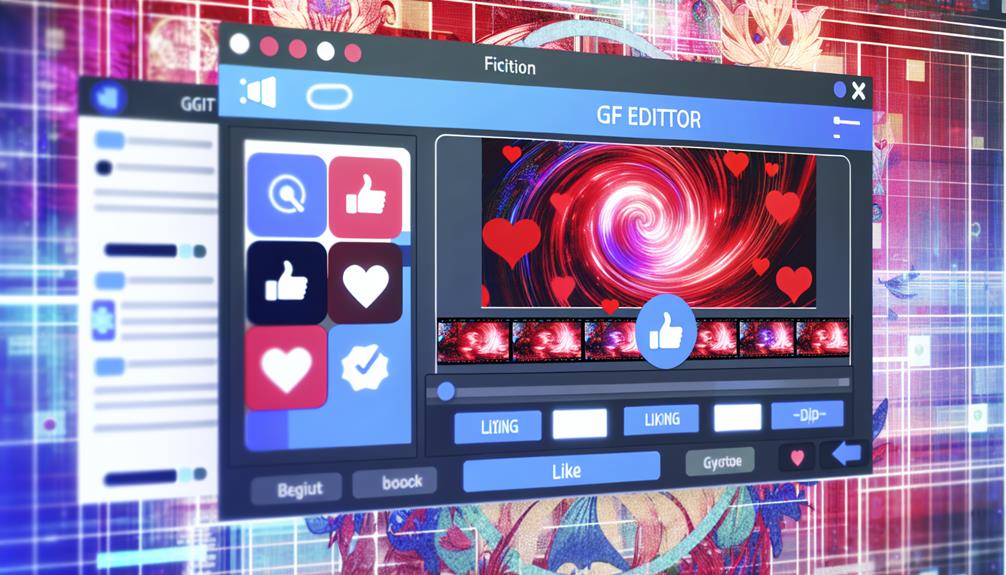Integrating images into GIFs on WordPress greatly boosts user engagement by creating visually dynamic content that grabs audience attention. This combination fosters relatable narratives, enhancing viewer retention and encouraging interactions. Tools like Adobe Photoshop and GIMP facilitate the layering of images with GIFs, allowing for compelling visual storytelling. By selecting high-quality images and optimizing GIF file sizes, creators can maintain website performance while enthralling visitors. Effective promotion on social media also amplifies reach and engagement. Exploring best practices in GIF enhancement can open even more potential for your visual projects, inviting deeper connections with your audience.
Key Takeaways
- Combine GIFs with relevant images to create compelling narratives that enhance viewer engagement and emotional connection.
- Use tools like Adobe Photoshop and GIMP to layer images and animate GIFs for a dynamic visual experience.
- Optimize image formats (JPEG for vibrant colors, PNG for transparency) to balance quality and loading speed on WordPress.
- Implement compression techniques and lazy loading to improve GIF loading times and overall website performance.
- Promote enhanced GIFs on social media with engaging captions, ensuring they align with your brand's overall message for better audience reach.
Understanding GIFs and Images

GIFs, or Graphics Interchange Format files, are a popular choice for conveying emotions and messages in a dynamic, visual format. Since their inception in 1987, GIFs have evolved markedly, becoming a staple in digital communication. Their rich history reflects the changing landscape of image trends, particularly in social media and online interactions. Initially celebrated for their ability to display simple animations, GIFs are now a versatile medium that can encapsulate humor, nostalgia, and relatable moments. Strengthening intimacy through creative expression can further enhance the emotional impact of these visuals.
As the digital era progresses, the trends surrounding GIFs and images have shifted, emphasizing the importance of visual storytelling. The rise of meme culture and the demand for instant communication have solidified GIFs as an essential tool for engagement. They not only capture attention but also foster a sense of belonging among users who share similar interests and emotions. By integrating GIFs with images, content creators can enhance their narratives, making them more relatable and impactful. In this age of rapid information consumption, understanding the synergy between GIFs and images is vital for those looking to connect authentically with their audience, inviting them into a shared visual experience that resonates on a personal level.
Benefits of Combining GIFs and Images
The combination of GIFs and images offers a unique opportunity for content creators to elevate their visual storytelling. By merging the dynamic nature of GIFs with the clarity of still images, creators can craft compelling narratives that resonate with their audience. This technique captures attention more effectively than standard images or videos alone, fostering a deeper connection with viewers. The addictive nature of engaging content, similar to the allure of clicker games, can greatly enhance viewer retention and participation.
Incorporating GIFs into images enhances audience engagement, as it introduces movement and emotion, making content more relatable and shareable. This multifaceted approach not only attracts viewers but encourages them to participate actively, whether through comments, shares, or likes. Engaging visuals can also evoke feelings and memories, which strengthens the bond between the creator and their audience.
Moreover, this combination allows for versatility in content presentation, catering to diverse preferences within the audience. Whether through storytelling in blog posts, social media updates, or marketing campaigns, the synergy of GIFs and images can greatly amplify the impact of your message. By leveraging these tools, content creators can foster a sense of belonging, drawing their audience into a shared experience that enriches their overall engagement.
Tools for Creating GIFS With Images

How can content creators effectively combine still images and animated GIFs to enhance their projects? The key lies in selecting the right tools and employing innovative techniques. Various software options are available for GIF creation, allowing users to integrate image overlays seamlessly. Programs like Adobe Photoshop and GIMP offer powerful features for layering images and animating them, facilitating sophisticated visual storytelling. Incorporating elements from different mediums, such as full-body strength, can further enhance the engagement factor of your GIFs.
Utilizing animation techniques, such as frame-by-frame animation or tweening, can elevate the viewer's experience. These methods not only breathe life into static images but also adhere to essential design principles, ensuring the final product is aesthetically pleasing.
Creative combinations of imagery can serve as a potent engagement strategy, enchanting audiences and fostering a sense of community around shared interests. By leveraging these tools, content creators can craft GIFs that resonate emotionally, bridging the gap between stillness and motion.
Ultimately, mastering these software options empowers creators to tell compelling stories, inviting viewers to engage more deeply with their content. Embrace the art of blending images and GIFs, and watch as your projects transform into dynamic visual experiences that invite connection and conversation.
Step-by-Step Guide to Adding Images
To successfully enhance your GIFs on WordPress, it is essential to choose the right image formats that balance quality and file size. Understanding the investment implications of cosmetic treatments can also apply to your creative projects, as making thoughtful choices can lead to better results. Additionally, utilizing image editing tools can greatly improve the visual appeal and coherence of your GIFs. This guide will outline the essential steps to guarantee your images complement your animated content effectively.
Choose Image Formats Wisely
When adding images to GIFs on WordPress, selecting the right image format can considerably impact both the visual quality and loading speed of your content. Understanding image resolution and color profiles is essential for creating engaging visuals that resonate with your audience.
JPEG is a popular choice for photographs due to its ability to compress high-resolution images while maintaining reasonable quality. This format supports a wide range of color profiles, making it ideal for vibrant images. However, be mindful that JPEGs can lose some detail with compression, which may affect the overall aesthetic of your GIF.
On the other hand, PNG is preferred for images requiring transparency or sharper lines, such as logos and graphics. It supports higher image resolutions without compromising quality and is particularly effective in preserving color profiles, ensuring your visuals remain striking regardless of the platform.
Consider your audience's experience when choosing your image formats. A balance between quality and loading speed will enhance engagement and encourage a sense of belonging within your community. By making informed decisions about image formats, you can elevate your GIFs and create a more enthralling WordPress presence.
Use Image Editing Tools
A thorough understanding of image editing tools can greatly enhance your ability to add images to GIFs on WordPress effectively. Utilizing creative editing software will allow you to manipulate your images skillfully, transforming simple graphics into visually compelling content that resonates with your audience.
Begin by selecting a user-friendly editing tool, such as Adobe Photoshop or GIMP, which offer robust features for image layering techniques. Start by importing your GIF and the images you wish to add. Layering is essential; it allows you to position images seamlessly within your GIF, enhancing the overall aesthetic without compromising the GIF's integrity.
Next, focus on blending and transparency options to guarantee that the added images harmoniously integrate with the GIF's original elements. By adjusting opacity and applying filters, you can create a cohesive look that captivates viewers.
Lastly, don't forget to save your project in a compatible format for WordPress, guaranteeing ideal quality and performance. By mastering these image editing tools, you not only enrich your GIFs but also forge a deeper connection with your audience, fostering a sense of belonging through engaging visual storytelling.
Best Practices for Image Selection

Selecting the right images for your GIFs is vital, as it can greatly impact viewer engagement and overall effectiveness. Begin by identifying relevant image themes that resonate with your audience. Consider the purpose of your GIF—whether it's to inform, entertain, or inspire—and choose images that align with this intent. For example, if you're sharing motivational content, vibrant and uplifting imagery can enhance the message. Additionally, just as choosing the right exercise is important for various age groups and fitness levels, selecting appropriate images can help cater to the diverse preferences of your audience finding the right exercise.
Moreover, achieving color harmony is essential for creating visually appealing GIFs. Colors evoke emotions and can influence viewer perceptions, so select images that complement each other and the overall color palette of your website. A cohesive color scheme not only beautifies your GIF but also strengthens your brand identity, fostering a sense of belonging among your audience.
Lastly, always prioritize image quality. Blurry or pixelated visuals detract from your message and can cause viewers to disengage. High-resolution images that are crisp and clear will guarantee that your GIFs maintain professionalism and clarity. By following these best practices for image selection, you can create engaging GIFs that not only attract attention but also resonate deeply with your audience.
Optimizing GIFs for Web Use
To guarantee that GIFs perform at their best on your WordPress site, it's vital to focus on file size management, format compatibility, and loading speed optimization. By carefully balancing these elements, you can enhance user experience while maintaining the visual appeal of your content. Let's explore effective strategies for making your GIFs web-ready without compromising quality.
File Size Management
Optimizing GIFs for web use is essential for enhancing website performance and user experience. As we endeavor for a seamless online environment, managing file sizes becomes a critical component. GIFs, while engaging, can quickly inflate page load times if not handled properly. Utilizing effective compression techniques can notably reduce file sizes without sacrificing quality.
Explore various tools that specialize in GIF compression, allowing you to balance visual appeal with performance. For instance, employing lossless compression can keep your GIFs sharp while minimizing their footprint. Additionally, consider alternative file types, such as MP4 or WebP, which can offer better compression rates while maintaining the essence of your animated content.
Format Compatibility
Understanding format compatibility is vital when incorporating GIFs into your WordPress site, as it directly impacts how these animations are displayed across different devices and browsers. Different image filetypes come with unique attributes that can affect user experience. While GIFs are popular for their motion capabilities, they have inherent limitations, such as a restricted color palette and larger file sizes compared to alternatives like WebP or APNG.
To guarantee your GIFs are effectively displayed, it's important to take into account the compatibility of these filetypes with various browsers. For instance, while GIFs generally perform well on most platforms, certain browsers may struggle with playback or quality. This can lead to a disjointed viewing experience that detracts from the intended engagement.
Additionally, understanding the context in which your GIFs will be used can guide your choice of format. If your audience primarily accesses your content on mobile devices, prioritizing formats that adapt seamlessly across screens will be key. By recognizing these nuances in format compatibility, you can strategically enhance user engagement and foster a sense of connection within your community.
Loading Speed Optimization
When incorporating GIFs into your WordPress site, one of the most critical factors to take into account is loading speed. Slow-loading GIFs can lead to user frustration and increased bounce rates, hampering your site's engagement potential. To optimize GIFs for web use, employing effective loading techniques and compression methods is essential.
Consider the following strategies to enhance your GIFs' loading speed:
| Technique | Description | Benefits |
|---|---|---|
| Image Compression | Reduce file size without losing quality | Faster loading times |
| Lazy Loading | Load GIFs only when they appear in the viewport | Improved initial load speed |
| GIF Optimization | Use tools to minimize frame count | Smoother user experience |
| Responsive Design | Adapt GIFs to various screen sizes | Enhanced accessibility |
| CDN Usage | Distribute content via a CDN | Reduced latency |
Promoting Your Enhanced GIFs

Promoting your enhanced GIFs effectively can greatly increase engagement and visibility across your WordPress site. By leveraging strategic promotional tactics, you can elevate user interaction while reinforcing your branding consistency. Here are some key strategies to reflect on:
- Leverage Social Media: Share your GIFs across various platforms like Instagram, Twitter, and Facebook. Each platform offers unique opportunities for visual storytelling that can enhance audience engagement.
- Optimize Captions: Craft compelling captions that not only describe your GIFs but also evoke emotions and invite conversations. Effective captions can markedly boost content sharing and user interaction.
- Maintain Design Aesthetics: Confirm that your GIFs align with your overall branding. Consistent design aesthetics can create a cohesive experience for your audience, making your content easily recognizable.
Frequently Asked Questions
Can I Add Audio to GIFS Along With Images?
While GIFs inherently do not support audio formats, it is possible to create engaging content by combining GIFs with audio in other formats. Utilizing video formats allows for synchronization of visuals and sound, enhancing the overall experience. For effective gif creation, consider using tools that allow you to export your work as video files, thereby enabling the incorporation of audio. This strategy not only enriches content but also fosters a deeper connection with your audience.
What File Formats Work Best for Images in GIFS?
When considering the best file formats for images in GIFs, both image quality and file size are critical factors. PNG and JPEG formats are commonly used; PNGs offer superior quality and support transparency, while JPEGs provide smaller file sizes, making them ideal for web applications. Balancing these aspects guarantees peak engagement without compromising performance. Selecting the right format enhances visual appeal, fostering a sense of belonging among users who appreciate high-quality content.
How Can I Track Engagement From My Enhanced GIFS?
To effectively track engagement from your enhanced GIFs, focus on key engagement metrics such as views, shares, and click-through rates. Implement analytics tools to measure these metrics and gather user feedback through surveys or comment sections. This data not only provides insights into audience preferences but also fosters a sense of belonging by encouraging community interaction. By analyzing these elements, you can strategically refine your content to better resonate with your audience.
Are There Copyright Concerns When Using Images in GIFS?
When using images in GIFs, copyright concerns are paramount. It is essential to understand image licensing and the nuances of fair use. Licensed images require permission for use, while fair use may allow limited use without consent under specific circumstances, such as educational or transformative purposes. To foster a respectful and legally compliant creative environment, always verify the licensing status of images and consider seeking permission when in doubt, ensuring ethical engagement with content.
Can I Animate the Images Within the GIF?
Yes, you can animate images within a GIF, creating dynamic animated overlays that enhance visual appeal. By strategically incorporating GIF effects, such as shifts or movements, you can capture your audience's attention and foster a sense of belonging. This approach not only enriches the viewer's experience but also elevates your content's engagement levels. Experimenting with various animation techniques will help you discover the most effective ways to convey your message creatively.

